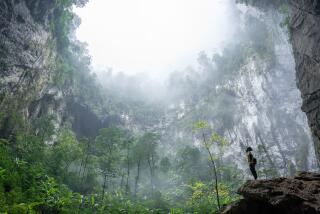In 21st Century War, 2 Cavemen Stand Out
- Share via
WASHINGTON — The hunt for Osama bin Laden has come down to this: two men in two caves half a world apart, conducting the first subterranean war of the 21st century.
One commands the most advanced weapons and technology on Earth. The other, little more than the ancient tools of the hunted--stealth and cover.
As U.S. military operations focus on the Taliban’s mountainous redoubts near Tora Bora in northeastern Afghanistan, Vice President Dick Cheney is presiding over the hunt for Bin Laden and his Al Qaeda lieutenants from a secret command center drilled hundreds of feet down into the super-hard granite of a mountain on the East Coast.
A honeycomb of chambers with room for 3,000 workers, it has its own power generators, air conditioning and water purification systems. Shielded by steel blast doors and concrete reinforcements, Cheney’s bunker was built to withstand a direct hit by an atomic bomb.
There, the vice president and his aides receive all dispatches from U.S. military commands and intelligence agencies worldwide. At their fingertips is a communications system with global reach, plus computers designed to replicate crucial Defense Department databases and files. Indeed, as a hauntingly prescient test demonstrated in a mock war last April, the command and control facility is capable of serving as backup if the entire Pentagon goes down.
More than 7,000 miles away, as autumn snows settle onto Afghanistan’s White Mountains, Bin Laden and the surviving members of his inner circle are believed to have taken refuge in a far more austere underground retreat.
“He’s got what he believes to be a fairly secure facility,” Cheney said of Bin Laden’s cave network.
“Believes to be” has turned out to be the operative phrase. According to administration and military sources closely involved in operations around Tora Bora, Afghanistan’s vaunted caves and secret tunnels are turning out to be surprisingly vulnerable to air attack.
Located about 45 miles south of Jalalabad along the rugged Afghan border with Pakistan, the vast network of natural and man-made tunnels and caverns are often portrayed as impenetrable. That turns out not to be true, at least not against modern-day warfare.
Moreover, with the Taliban a shambles elsewhere, the focus of U.S. military efforts--which have put considerable emphasis on the caves for some time--has become more and more intense.
And every day, the United States works with more and better intelligence information.
Afghanistan’s rugged terrain and cave networks have long been a focus of military attention. A U.S. Army specialist on the moujahedeen campaign against Soviet occupiers in the 1980s described the famous Zhawar Kili al Badr base built into Sodyaki Ghar mountain. Eleven huge tunnels were carved 1,600 feet into the earth. Zhawar contained “a hotel, a mosque, arms depots and repair shops, a garage, a medical point, a radio center and a kitchen,” the Army analyst reported.
Caverns a Target From the Start
In other words, facilities like those around Tora Bora are well known to the CIA.
From the very beginning of the war, “we have had an active campaign underway to take out some of these underground facilities,” Cheney said recently.
That was only partially true in the earlier stages of the war. Initially, Tora Bora and similar complexes had to compete with other targets for the attention of U.S. war planners. Between Sept. 11 and the initiation of Operation Enduring Freedom, for instance, there were numerous intelligence sightings of Bin Laden in Kandahar, then the Taliban’s stronghold.
As the bombing accelerated, however, and the war progressed, the situation changed.
Afghanistan is the size of Texas. But the rapid erosion of Taliban control of the countryside meant that the amount of enemy territory U.S. intelligence agencies had to watch began to shrink.
U.S. reconnaissance, led by Predator and Global Hawk drone aircraft that are capable of flying missions more than 30 hours long, allowed almost constant “staring” coverage of ever more limited terrain.
Meantime, the Taliban’s retreat made it easier for special operations units on the ground to get closer to the mountains and valleys near suspected cave systems. Working with laptop computers and radio relays, these units could pass higher-quality targeting data directly to command centers in Saudi Arabia and Florida.
Intelligence Flows as Taliban Fades
Most crucially, as Afghanistan imploded, the “take” in human intelligence--information gathered from village residents, refugees, deserters and prisoners--exploded.
“We have worked through all of the intelligence capabilities that we and our coalition partners have,” said Gen. Tommy Franks, commander of the operation, in describing the process of focusing on the caves. “We have been able to watch a variety of terrain and undertake review of a whole variety of imagery and talk to an awful lot of people.”
Franks’ prosaic words belie the drama and danger of the missions behind them.
As the knowledge base has expanded, attacks on the underground facilities have unfolded in a way that might surprise military experts and others who have portrayed the caves as impregnable fortresses that only ground troops could breach.
Though the systems are vast in scope, knowledgeable sources stress that Afghan caves--unlike Cheney’s command center--are individually quite vulnerable. They are carved out of porous limestone. They are not reinforced. They have poor ventilation and little fire-control equipment.
In fact, the notion that only the heaviest of “bunker busting” weapons could be effective is completely at odds with the actual task at hand, sources say. Just a handful of deep-digging, 5,000-pound, earth-penetrating weapons have been expended in the past eight weeks.
As U.S. aircraft began to hit Tora Bora around the 10th day of bombing, damage assessors watched 2,000-pound bombs with delayed fuses penetrate deep into the mountain, causing caves to collapse and deadly fires to break out.
Some 400 satellite-guided, 2,000-pound bombs with hardened casings have been expended in this task, but even traditional “dumb” bombs have proved useful in attacking cave entrances.
“This is not going after some sort of Saddam Hussein buried-concrete steel bunker,” said a military officer. These White Mountains are not Appalachian granite.
This is not to say that the task of bringing justice to Bin Laden is just a matter of time. Even in a conflict that pits the Space Age against the Stone Age, there is no guarantee of success.
Indeed, many war fighters say privately that, as good as U.S. weapons are, it will take what they call “the golden BB” to hit Bin Laden--the military equivalent of a kid getting lucky with his air rifle.
The first difficulty is assessing what detonations inside mountains have accomplished in terms of ultimate American goals. Reports this week of the death of some 10 Al Qaeda lieutenants in cave bombings illustrate the problem: Reports filter out from local warlords and commanders but cannot always be confirmed by U.S. intelligence. For all its eyes in the sky, the United States cannot always tell whether it has been successful.
U.S. Tries to Keep Al Qaeda Guessing
Given this uncertainty about individual outcomes, U.S. targeters and planners systematically move down their lists, attacking complex after complex. At the same time, they try to play games inside the head of Al Qaeda--”Chinese water torture”-style, as one officer put it. “They never know when we’re going to figure it out.”
Still, not all the advantages go to the attackers.
Cheney and other U.S. officials may have reinforced bunkers filled with state-of-the-art computer systems, secure video-teleconferences and bandwidth enough to make an Internet junkie drool, but they also don’t know everything in the fight against a pre-21st century opponent.
“We might have been pretty successful so far,” says one source, “but who knows?”
Given the number of potential hiding places, and the difficulty bomb damage assessment specialists have in determining just who or what was destroyed, pressure increases almost daily from inside and outside the Pentagon for U.S. special operations forces and British SAS Sabre commandos to get in there and finish the job.
What is more, Northern Alliance commanders in Jalalabad boast that as many as 3,000 fighters are going to enter the cave-riddled region.
In support of this pursuit, U.S. and allied ground forces will have state-of-the-art equipment, but they will face a challenge as old as the cavemen: the possibility, in a snowy and chaotic landscape, that the hunted will elude the hunter.
“We could get lucky and actually nail him,” said a retired American officer, but he compared the situation to hunting deer back home.
Some hunters, the “drivers,” work their way through the woods steering their quarry into the sights of other hunters waiting in blinds. Sometimes, however, the deer slip silently away, or simply freeze while the would-be drivers walk right past their prey without even knowing it.
What troubles the sleep of war planners is just this possibility: that despite their best efforts, Bin Laden will somehow slip, deer-like, away.
*
William M. Arkin is an adjunct professor at the U.S. Air Force’s School of Advanced Airpower Studies, a consultant to nonprofit organizations and academic institutions, and the author of several books on military affairs.
More to Read
Sign up for Essential California
The most important California stories and recommendations in your inbox every morning.
You may occasionally receive promotional content from the Los Angeles Times.













